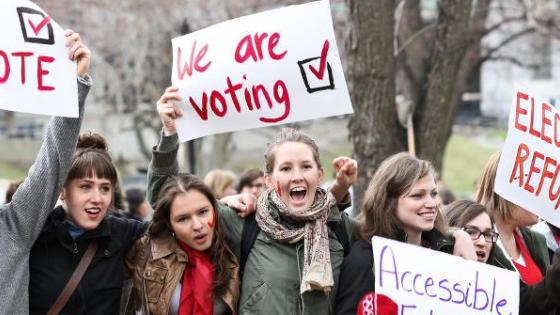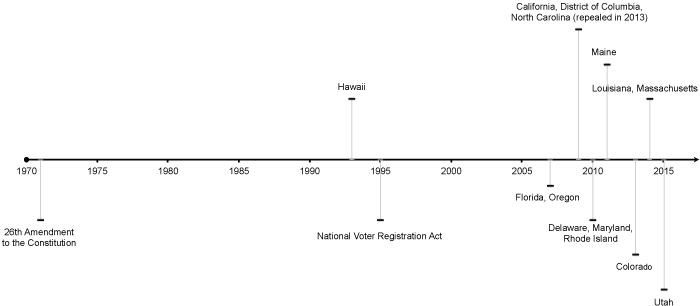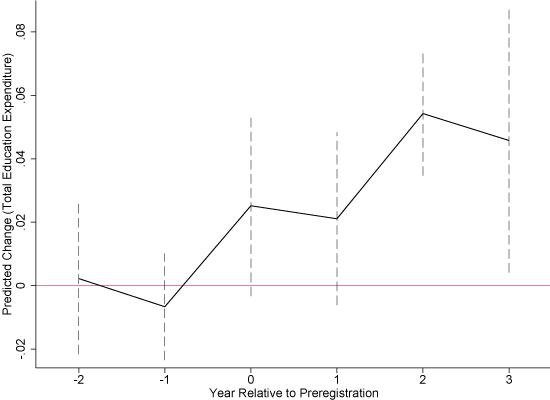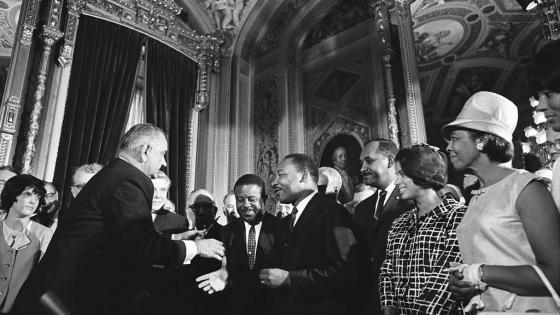In the UK referendum on Brexit, turnout was lowest among young voters (Becker et al. 2017). This is not surprising in view of the increasing tendency towards lower voter turnout among the young than the old in modern democracies. In the US, 18-year-olds were first given the vote in 1972. In the election that year, voter turnout was 52% in the 18-24 age group and 68% in the 25+ group. Since then, the gap has only widened. By the 2012 presidential election, the corresponding figures were 41% and 65%.1 A similar trend has been observed in Europe, with less than half of under-25s turning up to vote at general elections in many countries.
Low civic engagement among young voters is not just a democratic problem. It also carries relevant economic implications, since low electoral turnout leads to scarce interest of governments to meet the youth’s needs. This has long been recognised in the political economy literature (Meltzer and Richard 1981, Acemoglu and Robinson 2000, Lizzeri and Persico 2004). The main prediction of this literature is that increased electoral participation by a politically disadvantaged group is a precondition for the advancement of policies to its benefit. While the evidence supporting this claim is abundant for the case of conflict between rich and poor, or along racial and gender lines, the case of conflict between age groups has so far been neglected. This is surprising in view of the evolving demographic situation. In modern democracies, public spending favours pensions and health care (which benefit the old) over education expenditure (which benefits the young) (Economist 2016). This has become the focus of a policy debate and has raised concerns about the reluctance of the young to cast their ballot, and whether it is still the most effective way to make politicians responsive to a group’s demands.
In order to devise solutions to low civic engagement among young voters, several countries have reformed or are debating whether to reform their electoral system. For example, Austria, Germany, New Zealand, Norway, and the UK are currently considering whether to lower the voting age from 18 to 16. While the declared aim of reform is to promote more active social and political engagement among the young, what should we expect in terms of its impact on policy decisions?
While the above question is pressing in all democracies, in a new paper we provide an answer within the US context (Bertocchi et al. 2017). A contributing factor to low voter turnout among young Americans is a peculiar two-step voting process that requires eligible voters to register as a prerequisite for casting their ballot. Voter registration entails a cost – in terms of effort, time, and involvement – which is especially high for the young, who are meant to gather information and then show up at the voting stations for the first time. Easing the burden of registration has been the object of intense legislative activity.2 Among several electoral provisions, we focus on preregistration, whose declared goal is to encourage voting among the young. Preregistration allows young citizens to register before being eligible to vote, regardless of whether they will reach voting age prior to the next election. They can do so at points of frequent contact and socialisation, such as schools, campuses, or motor vehicle bureaus. Starting from 1993, 13 states and the District of Columbia have introduced preregistration laws. The timing is shown in Figure 1.
Figure 1 The timeline of preregistration legislation in the US
Voter preregistration and policy responsiveness
By exploiting the spatial and temporal variation of preregistration reforms and using annual financial data on the activity of state governments, we first show that in the post-reform period, per capita education expenditure is on average 6% higher in states that have adopted preregistration relative to states that have not.3 At the mean, this corresponds to an increase of about $47 per capita. The effect manifests itself after the first election following the passage of the law, and is independent of whether the governor at the time of budget approval was already in power in the reform year. This suggests that preregistration and education funding do not belong to a single youth-oriented reform package – which in turn implies that, with respect to fiscal policy, the enactment of preregistration can be viewed as exogenous, and its effect as causal. Figure 2 plots the predicted change in education expenditure and shows that no significant variation emerges in the pre-reform years, followed by a significant increase lasting up to the third post-reform year.
Figure 2 Predicted changes in total education expenditure
Note: Year 0 refers to the preregistration year and dotted lines refer to the 90% confidence interval.
Moreover, the positive effect of preregistration operates entirely through current expenditure on higher education, rather than elementary-secondary education or capital outlays, i.e. the component of education expenditure that directly affects the prospects of young soon-to-become voters who are enrolled in college or about to be. Finally, the increase in education expenditure is larger in states where political competition is weaker or inequality is higher, i.e. where parties appropriate higher political rent or the share of poor students in need of financial aid is larger.
The beneficial effect of preregistration on government spending in favour of the young is confirmed with an alternative dataset describing the activity and characteristics of US colleges, universities, and technical and vocational institutions.4 We compare institutions located in contiguous counties and exploit policy discontinuity at state borders. Figure 3 displays the location of the border-county pairs on a map of the US that distinguishes between counties in states that have introduced preregistration and those in states that have not.
Figure 3 Geographical distribution of adjacent counties along US state borders in 2015
Note: Darker shading indicates states with preregistration.
We show that in the post-reform period preregistration is associated with a 4.3% increase in the share of grants financed through state funding within total student aid, and a 7.1% increase in the number of their recipients as a proportion of all students. This implies that, at the mean, preregistration leads to an increase in state grants of about $1,640 per student and 53 additional state grant recipients per institution. In contrast, other components of student aid, such as federal (Pell) grants and grants financed by the institutions themselves, are unaffected by reform.
Voter preregistration and political participation
According to the political economy literature, politicians may have adopted policies that are more aligned with the preferences of the young in view of a potential de facto youth enfranchisement episode. To test this hypothesis, we lastly explore the link between preregistration and political participation. Using individual-level survey data on voting, we show that preregistration mobilises the young to vote more than other age groups.5 The estimated relative increase in young voter turnout is 4.6%. The findings therefore suggest that a large number of young individuals, who otherwise would not have had a political voice, are de facto enfranchised when they take advantage of preregistration.
Overall, the evidence paints a consistent picture. Politicians responded to the de facto youth enfranchisement episodes of the 2000s in a manner consistent with the main insight of the political economy literature, i.e. by increasing the type of expenditures that meet their needs. Thus, recent attempts to roll back preregistration in some US states, which would make voter registration more restrictive, may be misguided not only because this would disenfranchise young voters, but also because it would weaken the political incentive to implement fiscal policies that benefit the accumulation of human capital, such as the provision of affordable public education.6
Whether similar findings can be replicated in other contexts is a question ripe for investigation, especially since youth disenchantment with the ballot is becoming a growing phenomenon across democracies. Our empirical evidence confirms that we can expect electoral reform to have a stronger impact on public policy in countries characterised by weak political competition, high inequality or an aging population. Future research should investigate these issues in different settings.
References
Acemoglu, D, and J A Robinson (2000), “Why Did the West Extend the Franchise? Democracy, Inequality, and Growth in Historical Perspective”, Quarterly Journal of Economics 115: 1167-1199.
Becker, S O, F Fetzer and D Novy (2017), “Who Voted for Brexit? A Comprehensive District-Level Analysis”, paper presented at the Economic Policy 65th Panel Meeting, April.
Bertocchi, G, A Dimico, F Lancia and A Russo (2017), “Youth Enfranchisement, Political Responsiveness, and Education Expenditure: Evidence from the U.S.”, CEPR Discussion Paper no. 12332.
Lizzeri, A, and N Persico (2004), “Why Did the Elites Extend the Suffrage? Democracy and the Scope of Government, with an Application to Britain's Age of Reform”, Quarterly Journal of Economics 119: 707-765.
Meltzer, A H and S F Richard (1981), “A Rational Theory of the Size of Government”, Journal of Political Economy 89: 914-927.
The Economist (2016), “Generation Uphill”, 23 January.
Endnotes
[1] Young voter turnout rates are available from the Center for Information and Research on Civic Learning and Engagement, at http://civicyouth.org/quick-facts/youth-voting.
[2] We refer to the National Voter Registration Act of 1993, the so-called Motor Voter Act, that greatly eased the registration process by enabling eligible voters to register at motor vehicle bureaus, and two pieces of legislation introduced by individual states, Election Day Registration and Online Registration.
[3] Data is taken from the Annual Survey of State and Local Government Finances conducted by the US Census Bureau for the period 1980-2014.
[4] Data is taken from the Integrated Postsecondary Education Data System published by the Delta Cost Project Dataset for the period between the academic years 2001-2002 and 2011-2012.
[5] Data is taken from the Voting and Registration Supplement of the Current Population Survey carried out by the US Census Bureau for the period 1996-2014.
[6] By the 2016 presidential election, 15 states had introduced new and restrictive voting requirements, such as voter ID laws. This has been part of a broader tendency to curtail voting rights, which has been in place at least since the 2010 midterm election. See here for more information.









